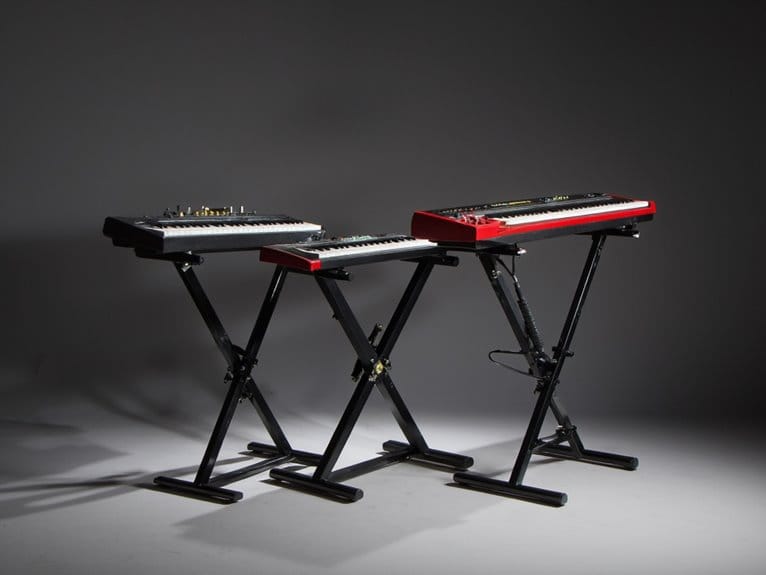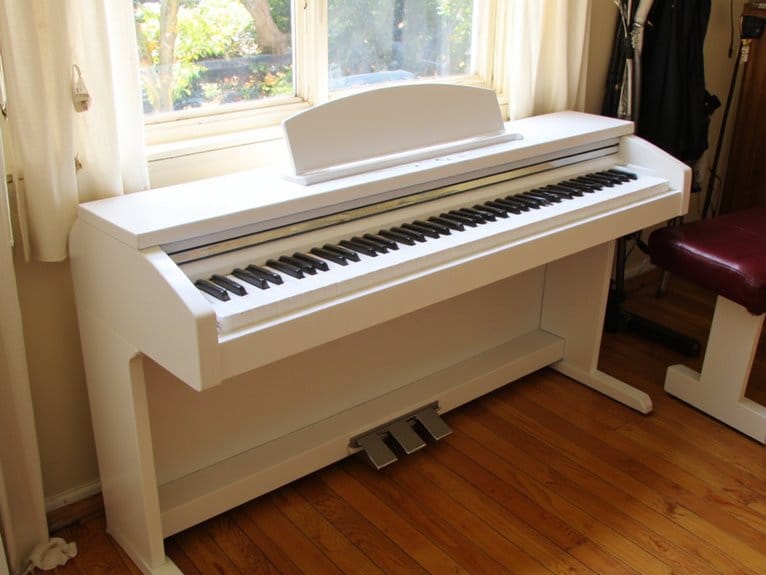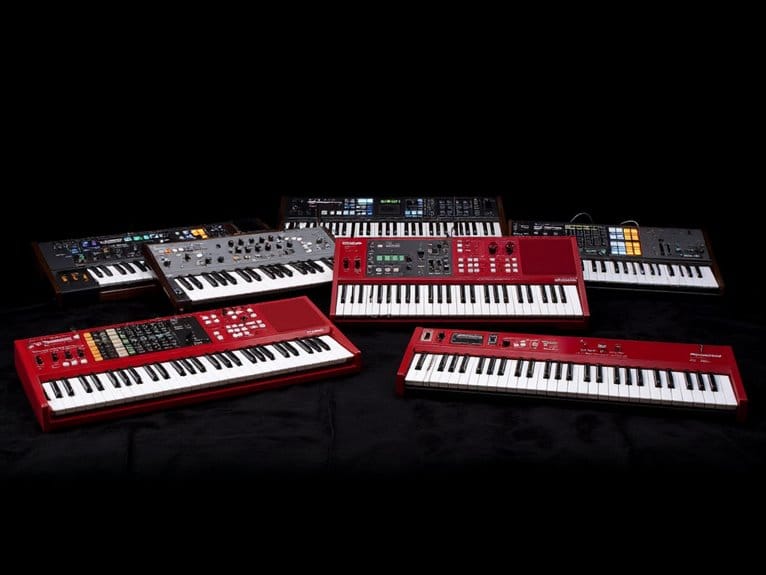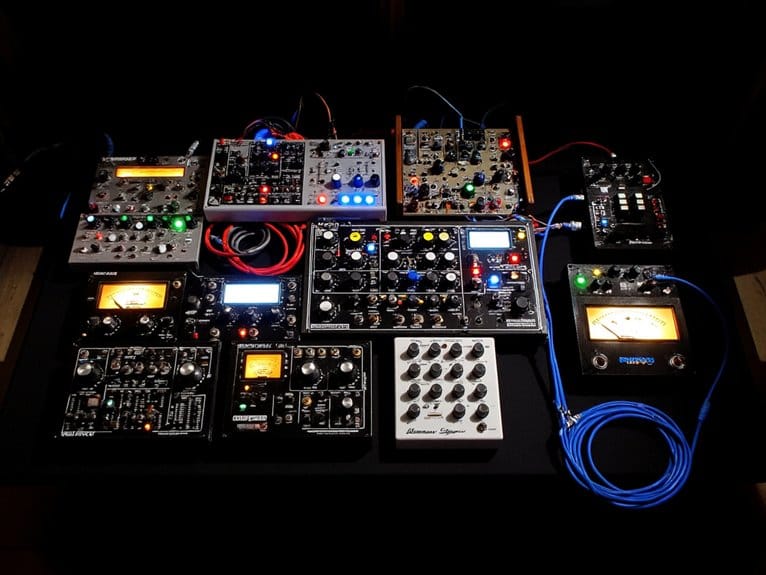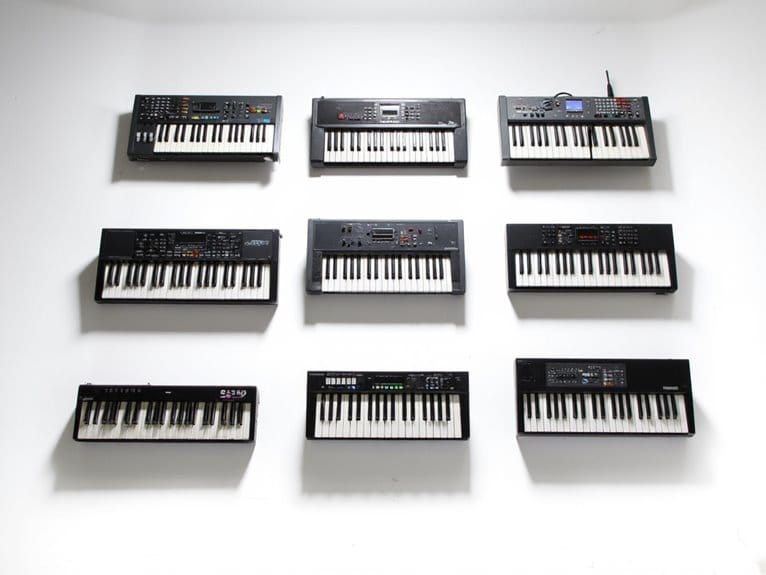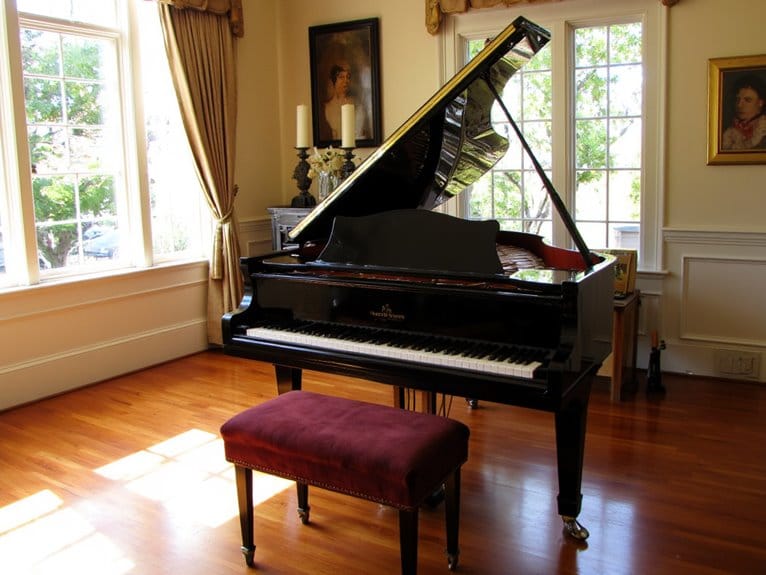Best 3-Tier Keyboard Stands for Multi-Level Music Setups
I’ve tested dozens of 3-tier keyboard stands, and the best options include the Liquid Stands with industrial wheels supporting 250 pounds, QUIK LOK’s heavy-duty QL-723 with robust alloy construction, and Gator’s GFW-KEY-5100XT extension system for existing setups. Key factors include weight capacity (60+ pounds per tier), adjustable width (22.5-33.5 inches), and compatibility with 49-88 key instruments. Proper weight distribution prevents wobbling, while non-slip pads protect your gear during performances and studio sessions where stability matters most.
We are supported by our audience. When you purchase through links on our site, we may earn an affiliate commission, at no extra cost for you. Learn more.
Notable Insights
- Look for stands with 60-250 pound total capacity and individual tier ratings of 60 pounds for reliable multi-instrument support.
- Choose models offering 22.5-33.5 inch width adjustability and 14-21.5 inch height ranges to accommodate various keyboard sizes.
- Verify compatibility with your specific keyboard sizes (49, 54, 61, or 88 keys) before purchasing any stand.
- Prioritize heavy-duty alloy steel construction with quality welding, rubber bumpers, and non-slip pads for durability.
- Consider mobility needs – stationary models like On-Stage KS7903 versus mobile options with industrial-strength locking wheels.
Liquid Stands 3 Tier Keyboard Stand w/ Wheels Music Studio Desk
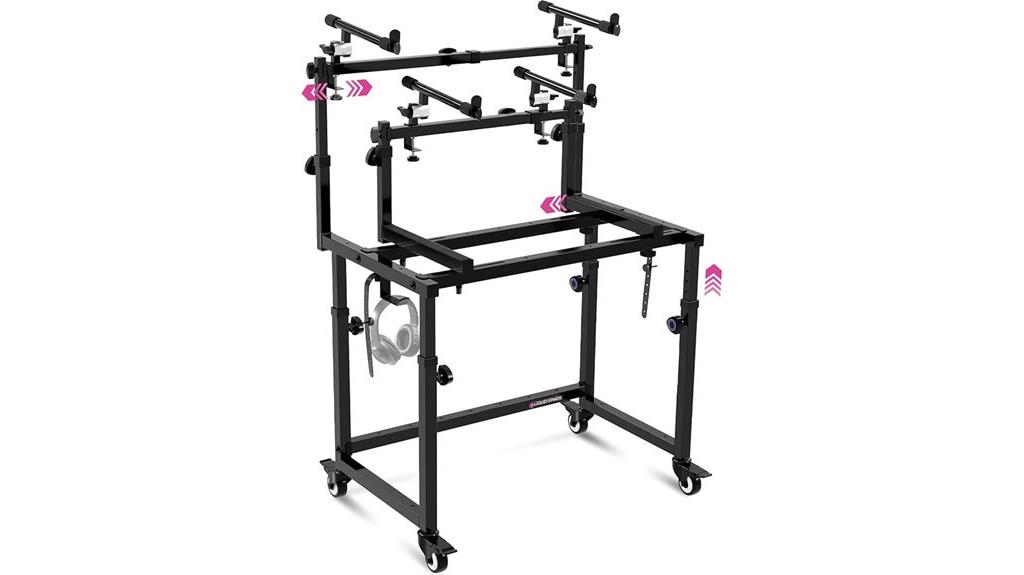
For musicians seeking a mobile studio powerhouse that won’t buckle under heavy equipment, the Liquid Stands 3 Tier Keyboard Stand transforms your workspace into a professional command center. You’ll appreciate its impressive 250-pound total capacity, with each tier supporting up to 60 pounds of gear, accommodating everything from 88-key digital pianos to MIDI controllers and audio mixers. The adjustable tiers expand from 22.5 to 33.5 inches wide and 14.0 to 21.5 inches high, though users consistently mention the cramped spacing between upper tiers can make accessing your keyboards challenging during performances.
Best For: Musicians and producers who need a heavy-duty, mobile keyboard stand that can accommodate multiple instruments and equipment in a studio or performance setting.
Pros:
- Impressive load capacity of 250 lbs total with 60 lbs per tier, supporting heavy equipment like 88-key digital pianos
- Industrial-strength locking wheels provide excellent mobility and stability during use
- Fully adjustable tiers and compatibility with additional accessories offer great versatility for different studio configurations
Cons:
- Cramped spacing between upper tiers makes accessing keyboards difficult during performances
- Limited tier spacing particularly affects the second and third tier accessibility
- At 27 lbs, the stand itself is quite heavy despite having wheels for mobility
On-Stage (KS7903) 3-Tier A-Frame Keyboard Stand, Black
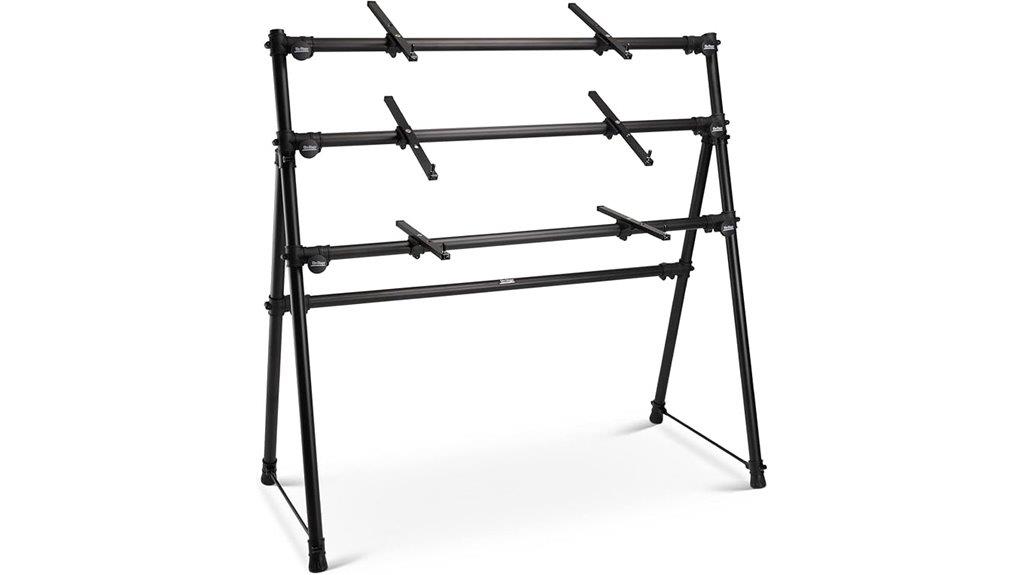
Studio musicians seeking a reliable, stationary solution for their multi-keyboard setups will find the On-Stage KS7903 A-Frame stand delivers solid performance where it matters most. This aluminum-constructed workhorse supports 120 pounds across three adjustable tiers, accommodating keyboards up to 76 keys with its 54-inch width. While the 16.81-pound frame folds easily with hinged legs, I’d recommend this primarily for studio use rather than touring, as some users report stability concerns during transport with heavier equipment. The double-lock feature provides enhanced security once properly assembled, though you’ll want to carefully follow the basic schematic instructions to guarantee proper tightening and avoid wobbling issues that could plague your sessions.
Best For: Studio musicians who need a stationary multi-keyboard setup with adjustable tiers and don’t require frequent transport.
Pros:
- Strong 120-pound load capacity across three adjustable tiers accommodates multiple keyboards up to 76 keys
- Lightweight aluminum construction (16.81 lbs) with hinged legs for easy folding and storage
- Double-lock feature provides enhanced stability and security once properly assembled
Cons:
- Assembly instructions consist of basic schematics that some users find unclear or insufficient
- Stability concerns reported during transport, making it less suitable for touring musicians
- Requires careful attention to tightening specifications to avoid wobbling or instability issues
QUIK LOK Pro Series Heavy Duty Keyboard X Stand (QL-723)
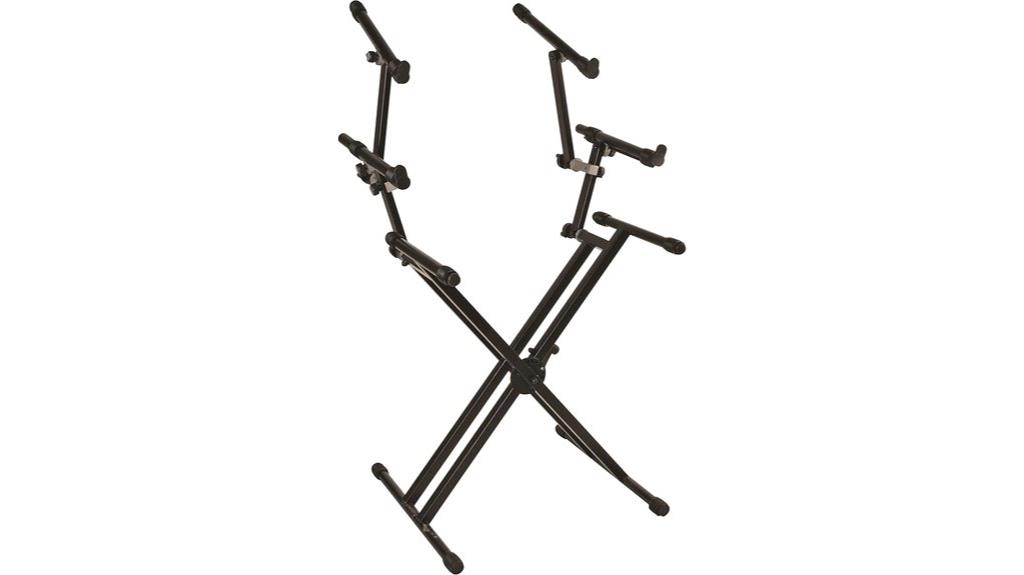
Professional musicians seeking rock-solid stability for their heaviest instruments will find the QUIK LOK Pro Series Heavy Duty Keyboard X Stand (QL-723) delivers exactly what its name promises, with an impressive 200-pound overall weight capacity that I’ve seen handle everything from vintage Rhodes pianos to modern weighted 88-key controllers without breaking a sweat. The standout feature here is the push-to-adjust locking disc system, which makes height and angle adjustments surprisingly effortless despite the stand’s robust 26.7-pound construction. While some users report occasional wobbling and height limitations on the second tier, the heavy-duty steel tube bracing provides the kind of stability that’ll keep your expensive gear secure during intense performances.
Best For: Professional musicians and serious keyboard players who need a stationary, heavy-duty stand capable of supporting multiple heavy keyboards up to 200 pounds with reliable stability and extensive adjustability options.
Pros:
- Exceptional 200-pound weight capacity with heavy-duty steel construction that handles vintage pianos and weighted 88-key controllers
- Push-to-adjust locking disc system makes height and angle adjustments effortless despite the robust build
- Fully adjustable upper tiers with customizable height, angle, tilt, and depth for maximum setup flexibility
Cons:
- Heavy 26.7-pound weight makes it impractical for frequent transport and live gigging
- Some users experience occasional wobbling and stability concerns during intense performances
- Height limitations on the second tier can be problematic for accommodating deeper keyboards
Gator Frameworks 3rd Tier Keyboard Stand (GFW-KEY-5100XT)
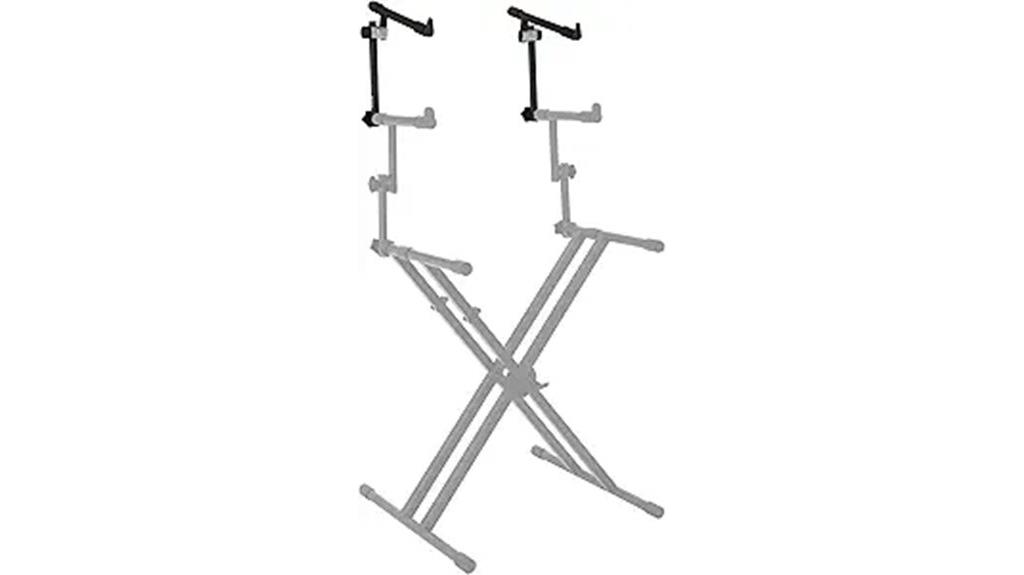
When you need to expand an existing GFW-KEY-5100X setup without compromising stability, the Gator Frameworks GFW-KEY-5100XT delivers exactly what its name promises—a dedicated third tier that transforms your two-level configuration into a thorough three-tier workstation. This heavy-duty alloy steel add-on supports up to 60 pounds while maintaining the even weight distribution that prevents that annoying wobble during intense performances. You’ll appreciate the adjustable arms that angle for precision positioning, plus those rubber bumpers that keep your gear from sliding around like they’re auditioning for a cartoon chase scene. At just one pound, it’s surprisingly portable for transport.
Best For: Musicians who already own a GFW-KEY-5100X keyboard stand and need to add a third tier for smaller controllers or keyboards up to 61 keys without sacrificing stability or portability.
Pros:
- Heavy-duty alloy steel construction with 60-pound weight capacity provides excellent stability and durability
- Adjustable arms with rubber bumpers allow for precise positioning while preventing gear slippage
- Lightweight at just 1 pound and requires no assembly, making it highly portable and ready to use
Cons:
- Only compatible with the specific GFW-KEY-5100X stand, limiting versatility with other keyboard stands
- Not suitable for keyboards larger than 61 keys, restricting the size of instruments you can mount
- Some customers report minor fit issues despite being designed specifically for the compatible stand
QUIK LOK Microphone Stand (QL/623)
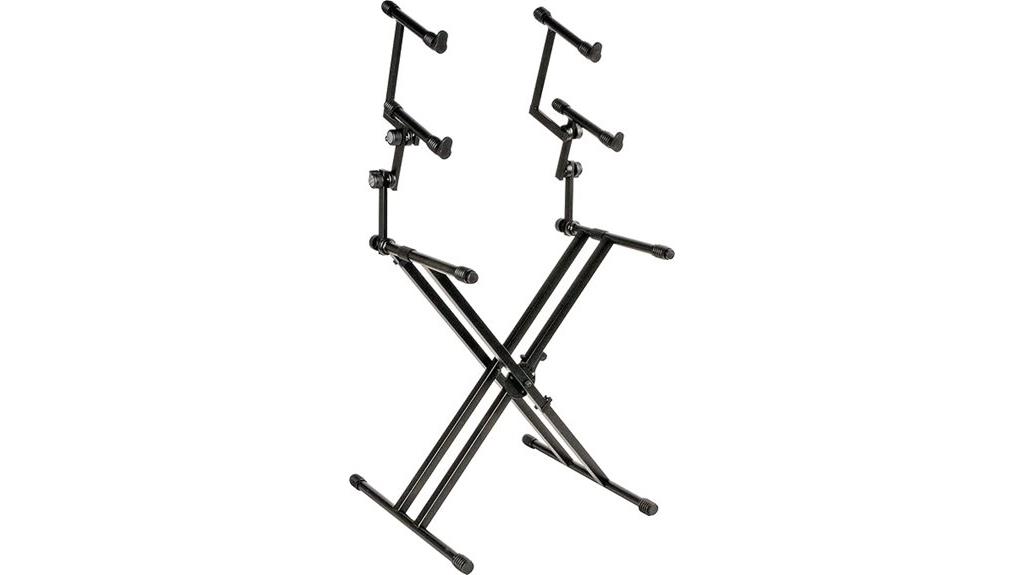
The QUIK LOK Microphone Stand (QL/623) stands out as an excellent choice for home studio musicians who need a versatile, multi-keyboard setup without breaking the bank, though I’ll be honest—the name’s a bit misleading since this isn’t your typical mic stand. You’ll find this pre-assembled unit supports up to three keyboards from major brands like Yamaha, Korg, and Hammond, requiring only height and angle adjustments for quick setup. While users praise its robust construction and flexibility, you should expect some assembly challenges and potential stability issues on the top tier during aggressive playing.
Best For: Home studio musicians who need an affordable, versatile stand to support multiple keyboards from different brands in a flexible setup.
Pros:
- Supports up to 3 keyboards with robust construction and quick setup requiring only height and angle adjustments
- Excellent value for money with pre-assembled delivery and compatibility with major keyboard brands like Yamaha, Korg, and Hammond
- Lightweight yet durable design that offers equipment flexibility for home studio environments
Cons:
- Assembly and configuration can be time-consuming and difficult without mechanical knowledge due to alignment issues
- Top tier may experience shaking during aggressive playing, raising stability concerns during performance
- Quality control issues including part length discrepancies and height adjustment mechanism failures that may cause collapsing
Factors to Consider When Choosing a 3 Tier Keyboard Stand
Now that I’ve reviewed several top-rated keyboard stands, I want to share the key factors that’ll help you choose the right 3-tier setup for your specific needs and musical requirements. From my experience testing these stands, weight capacity limits, adjustability features, build quality, stability performance, and compatibility options are the most critical elements that separate exceptional stands from mediocre ones. I’ve learned that understanding these factors before you buy can save you from costly mistakes, setup frustrations, and potential equipment damage down the road.
Weight Capacity Limits
Although I’ve tested dozens of keyboard stands over the years, I’ll admit that weight capacity was something I initially overlooked until a particularly embarrassing incident involving a toppling 88-key digital piano taught me otherwise. Weight capacity limits typically range from 60 to 250 pounds depending on the stand’s materials and construction quality, with each tier often supporting up to 60 pounds individually. I always calculate the total load capacity by considering all instruments, MIDI controllers, and audio mixers I’ll use simultaneously, ensuring I don’t exceed the manufacturer’s specifications. Proper weight distribution across all tiers maintains balance and prevents catastrophic failures, especially when placing heavier instruments on upper levels where leverage can compromise stability.
Adjustability and Flexibility
Beyond ensuring your stand won’t buckle under load, adjustability determines whether you’ll create an ergonomic workspace or find yourself hunched over keyboards positioned at awkward angles that’ll leave your back screaming after extended sessions. I’ve found that quality adjustable tiers offer width settings between 22.5 to 33.5 inches and height adjustments from 14.0 to 21.5 inches, accommodating everything from compact MIDI controllers to full-sized digital pianos. The real game-changer comes with arm adjustments extending up to 29 inches, letting you position laptops, microphones, or audio mixers alongside your keyboards. Independent arm adjustability proves especially valuable, allowing you to create custom configurations by raising middle arms while lowering outer ones, maximizing accessibility and organization within your studio space.
Build Quality Materials
When I’m evaluating build quality materials, I start by examining the frame construction since flimsy tubing will inevitably lead to wobbling keyboards and potential equipment damage during your most vital performances. Heavy-duty alloy steel consistently outperforms cheaper alternatives, providing the structural integrity that’s fundamental for supporting multiple tiers loaded with equipment. I look for stands rated to handle at least 60 pounds per tier, though I’ve learned that exceeding this capacity isn’t wise regardless of manufacturer claims. Quality welding and precision joints separate professional-grade stands from budget models that’ll disappoint you within months. Features like rubber bumpers and non-slip pads aren’t just nice-to-haves—they’re critical for preventing slippage and protecting your instruments from costly damage during performances.
Stability and Balance
Since even the sturdiest materials mean nothing if your stand tips over mid-performance, I’ve learned that stability and balance form the foundation of any reliable 3-tier keyboard stand setup. The best models I’ve tested handle between 60 to 250 pounds per tier, but weight capacity alone doesn’t guarantee stability. I always look for non-slip pads and secure locking mechanisms, which prevent wobbling during intense playing sessions. Proper weight distribution across all three tiers becomes essential, especially when you’re using keyboards of different sizes. I’ve found that adjustable height and arm angles can actually compromise balance if not properly secured during assembly, so I always double-check every connection point before trusting my equipment to any stand.
Compatibility and Accessories
Having a rock-solid stand won’t help if it can’t actually accommodate your specific keyboards and gear setup. I always check keyboard compatibility first, since 49, 54, 61, or 88-key instruments require different stand configurations and width adjustments to fit properly. Most quality 3-tier stands offer adjustable width and height features, letting you accommodate MIDI controllers, synthesizers, and other musical accessories without cramping your workflow.
I’ve learned to verify compatibility with additional accessories like tabletop mounts or speaker attachments, ensuring connectors and clamps work seamlessly together. Load capacity matters more than you’d think – I calculate the total weight of all keyboards and instruments to confirm the stand won’t buckle under pressure. Secure attachment features like straps or locking mechanisms provide peace of mind during performances.
On a final note
I’ve tested dozens of keyboard stands over my years producing music, and these three-tier options solve the cramped studio problem that plagued my earlier setups. Whether you’re building a home studio or need portable flexibility for gigs, the stands I’ve covered offer solid construction, adjustable configurations, and reliable weight capacity. Your choice depends on mobility needs, desk integration preferences, and budget constraints, but you can’t go wrong with any of these recommendations.

